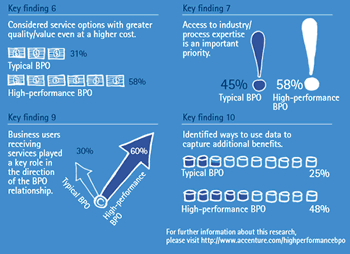The focus in the BPO (Business Process Outsourcing) market is shifting from a cost reduction proposition to a broader value proposition.
The same goes for BPO providers in the data, document imaging and case handling space, such as document service bureaux and document process outsourcers (DPOs), where multiple other challenges exist. These are among others as a consequence of growing client document management and high quality imaging solution requirements.
Smart business and document process outsourcing: the evolving approach to BPO
Information needs to be captured from documents quickly and efficiently managed with less room for manual errors than ever. Data needs to be turned into actionable data and information processes. Customer requirements grow, SLAs need to be met and reducing costs (e.g. labor-intensive processes) is key, as is the expansion of service offerings in the shift towards more value (amid the pressure of decreasing margins). The challenges for document process outsourcing and BPO are clear.
In order to develop value-oriented offerings, often in a digital transformation context, BPO providers need to optimize their own processes and reduce costs that add little value to their business and that of their customers.

All these market evolutions are happening as BPO customers go through digital transformation processes themselves. In a survey, Global Services found that 74 percent of high performers in the BPO industry focus on the potential value of business benefits beyond cost when creating their business case, compared to 26 percent of the rest.
Research from Accenture found that 58 percent of high-performance BPOs considered service options with greater quality and/or value even at a higher cost. Strategic relationships are crucial and receiving services plays a key role in the direction of the BPO relationship, Accenture states. Finally, 48 percent of high performers identified ways to use data to capture additional benefits, compare with 25 percent of typical BPOs.
Growth dynamics across 3 BPO segments
Regardless of the specialization, scope or activity of the BPO and DPO service provider, however, the need to optimize processes (reducing costs), find new opportunities (services) and respond to changing customer requirements with stronger value-based relationships, shapes the market of BPO providers, as it changes along with the digital transformations their customers face.
In that regard, it’s important to note that we typically see three “levels” or segments of BPOs who are each active across a mix of horizontal and vertical activities as mentioned on our BPO overview page.
The top layer: BPOs as end-to-end strategic partners
In the top tier we typically find companies that are strategic partners with highly specialized end-to-end process optimisation and management solutions. The companies in this segment focus on the top organizations within the verticals they serve. However, many of them are also moving to the SME market to expand their operations. The companies offering BPO services in this segment are often one stop shops, focusing on (out)sourcing but also on solutions, services, consulting and more (implementation, staffing,…). At the same time, many also work in a tailored way and de facto start with one or more services, even outside the context of a roadmap for future collaboration. From an (out)sourcing viewpoint, they go from project-based staffing to fully managed services and managed projects.
The middle layer: scaling up capabilities
The middle layer most often specializes in a set of specific processes or industries and increasingly goes beyond the operational dimension and document process outsourcing. In a highly competitive landscape they tend to meet competitors from the top layer (who start to expand into the midmarket where some of the players in this middle layer are active) and now and then BPOs from the third layer (below) who are even more focused but look for expansion within their niche. Some want to move more towards the top level, at least in expanding their BPO services into more strategic areas. Offering tailored solutions and approaches is one of their areas of growth but that’s also where they meet the top tier BPOs who are flexible enough to meet customer demands that don’t require a one stop shop offering.
Specialised BPOs: focus on efficiency
The third level is where we find even more specialized players. They often are and remain focused on very specific tasks such as capturing and digitizing high volumes of paper. Some of the companies here look for expansion as well. However, they will typically try to achieve it within their niche as mentioned. These BPOs have very strong traditional relationships with their customers due to their highly focused approach and often long-lasting relationships when the key focus was on cost reduction. Many want to keep that focus, even if the markets they operate in are often very competitive and margins erode. They look at technology as a way to differentiate themselves and increase efficiency while lowering costs.


